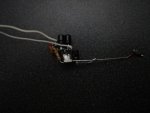- Joined
- Jan 20, 2008
- Messages
- 1,724
- Points
- 0
Having burnt out my last rkcstr driver and after waiting some 8 months for fusiondrives to arrive, I've been growing slowly more impatient, staring at these 803t diodes I can't play with...
After tearing apart all my spare electronics I haven't been able to find any LM317's, though a number of DVD burners I have contain 3 or more APL1117's...
I brought up this regulator before, and it seems they would be good to make drivers out of, in fact that's what the FusionDrives use... I would simply copy the schematics for the fusiondrive, but I can't seem to find any of the 1.2v voltage reference chips they use.
phenol posted this handy schematic for a potential driver design:

and I tried to build it using whatever parts I could find...
Not having access to any tantalum capacitors, and not being able to find ceramic capacitors in my junk bin that were more than 0.1uf, I used electrolytics...
I looked over the schematic a few times, and looked over what I built... and it seems I put it together correctly, though in place of the resistor I used a 1k pot and a 2ohm resistor, thinking I could play around with the resistance to see what works...
It doesn't seem to be regulating current since it fluctuates between 350-400mA as it heats up, and regardless of what I set the pot to it doesn't seem to make any difference.
I tried a dummy load of 5 diodes in series and within 10 seconds it had melted them. (at around 390mA)
Any idea what I'm doing wrong?
After tearing apart all my spare electronics I haven't been able to find any LM317's, though a number of DVD burners I have contain 3 or more APL1117's...
I brought up this regulator before, and it seems they would be good to make drivers out of, in fact that's what the FusionDrives use... I would simply copy the schematics for the fusiondrive, but I can't seem to find any of the 1.2v voltage reference chips they use.
phenol posted this handy schematic for a potential driver design:
and I tried to build it using whatever parts I could find...
Not having access to any tantalum capacitors, and not being able to find ceramic capacitors in my junk bin that were more than 0.1uf, I used electrolytics...
I looked over the schematic a few times, and looked over what I built... and it seems I put it together correctly, though in place of the resistor I used a 1k pot and a 2ohm resistor, thinking I could play around with the resistance to see what works...
It doesn't seem to be regulating current since it fluctuates between 350-400mA as it heats up, and regardless of what I set the pot to it doesn't seem to make any difference.
I tried a dummy load of 5 diodes in series and within 10 seconds it had melted them. (at around 390mA)
Any idea what I'm doing wrong?













